Synthesis of Molecularly Imprinted Polymer Nanoparticles for SARS-CoV-2 Virus Detection Using Surface Plasmon Resonance
Abstract
1. Introduction
2. Materials and Methods
2.1. Reagents and Chemicals
2.2. Apparatus and Equipment
2.3. Preparation of the Virus Culture
2.4. Synthesis of the NanoMIPs
2.4.1. Derivatization of Glass Beads
2.4.2. NanoMIP Synthesis and Yield Calculation
2.5. Characterization of NanoMIPs
2.6. SARS-CoV-2 Virus Detection Assay
3. Results and Discussion
3.1. Size and Stability of NanoMIPs
3.2. SARS-CoV-2 Virus Assay
3.3. AFM Characterization of NanoMIP Sensor
3.4. Electrochemical Characterization of NanoMIP Sensor
3.5. Kinetic Data Analysis
3.6. Cross-Reactivity Test
4. Conclusions
Author Contributions
Funding
Data Availability Statement
Conflicts of Interest
References
- DeBiasi, R.L.; Tyler, K.L. Polymerase Chain Reaction in the Diagnosis and Management of Central Nervous System Infections. Arch. Neurol. 1999, 56, 1215–1219. [Google Scholar] [CrossRef] [PubMed]
- Wright, P.F.; Nilsson, E.; Lelenta, M. Standardisation and Validation of Enzyme- Linked Immunosorbent Assay Techniques for the Detection of Antibody in Infectious Disease Diagnosis. Rev. Sci. Tech. 1993, 12, 435–450. [Google Scholar] [CrossRef] [PubMed]
- Walsh, M.G.; Sawleshwarkar, S.; Hossain, S.; Mor, S.M. Whence the next Pandemic? The Intersecting Global Geography of the Animal-Human Interface, Poor Health Systems and Air Transit Centrality Reveals Conduits for High-Impact Spillover. One Health 2020, 11, 100177. [Google Scholar] [CrossRef] [PubMed]
- Whiley, D.M.; Lambert, S.B.; Bialasiewicz, S.; Goire, N. False-Negative Results in Nucleic Acid Amplification Tests-Do We Need to Routinely Use Two Genetic Targets in All Assays to Overcome Problems Caused by Sequence Variation. Crit. Rev. Microbiol. 2008, 34, 71–76. [Google Scholar] [CrossRef] [PubMed]
- Amaral, C.; Antunes, W.; Moe, E.; Duarte, A.G.; Lima, L.M.P.; Santos, C.; Gomes, I.L.; Afonso, G.S.; Vieira, R.; Teles, H.S.S.; et al. A Molecular Test Based on RT-LAMP for Rapid, Sensitive and Inexpensive Colorimetric Detection of SARS-CoV-2 in Clinical Samples. Sci. Rep. 2021, 11, 16430. [Google Scholar] [CrossRef] [PubMed]
- Udugama, B.; Kadhiresan, P.; Kozlowski, H.N.; Malekjahani, A.; Osborne, M.; Li, V.Y.C.; Chen, H.; Mubareka, S.; Gubbay, J.B.; Chan, W.C.W. Diagnosing COVID-19: The Disease and Tools for Detection. ACS Nano 2020, 14, 3822–3835. [Google Scholar] [CrossRef]
- Vandenberg, O.; Martiny, D.; Rochas, O.; Belkum, A.; Kozlakidis, Z. Considerations for Diagnostic COVID-19 Tests. Nat. Rev. Microbiol. 2021, 19, 171–183. [Google Scholar] [CrossRef]
- Chau, C.H.; Strope, J.D.; Figg, W.D. COVID-19 Clinical Diagnostics and Testing Technology. Pharmacotherapy 2020, 40, 857–868. [Google Scholar] [CrossRef]
- Alafeef, M.; Dighe, K.; Moitra, P.; Pan, D. Rapid Ultrasensitive, and Quantitative Detection of SARS-CoV-2 Using Antisense Oligonucleotides Directed Electrochemical Biosensor Chip. ACS Nano 2020, 14, 17028–17045. [Google Scholar] [CrossRef]
- Kim, J.; Mayorga-Martinez, C.C.; Vyskočil, J.; Ruzek, D.; Pumera, M. Plasmonic-Magnetic Nanorobots for SARS-CoV-2 RNA Detection through Electronic Readout. Appl. Mater. Today 2022, 27, 101402. [Google Scholar] [CrossRef]
- Lu, C.; Zhang, Y.; Tang, S.; Fang, Z.; Yang, H.; Chen, X.; Chen, G. Biosensors and Bioelectronics Sensing HIV Related Protein Using Epitope Imprinted Hydrophilic Polymer Coated Quartz Crystal Microbalance. Biosens. Bioelectron. 2012, 31, 439–444. [Google Scholar] [CrossRef]
- Navakul, K.; Sangma, C.; Yenchitsomanus, P.-T.; Chunta, S.; Lieberzeit, P.A. Enhancing Sensitivity of QCM for Dengue Type 1 Virus Detection Using Graphene-Based Polymer Composites. Anal. Bioanal. Chem. 2021, 413, 6191–6198. [Google Scholar] [CrossRef]
- Afzal, A.; Mujahid, A.; Schirhagl, R.; Bajwa, S.Z.; Latif, U.; Feroz, S. Gravimetric Viral Diagnostics: QCM Based Biosensors for Early Detection of Viruses. Chemosensors 2017, 5, 7. [Google Scholar] [CrossRef]
- Altintas, Z.; Gittens, M.; Guerreiro, A.; Thompson, K.A.; Walker, J.; Piletsky, S.; Tothill, I.E. Detection of Waterborne Viruses Using High Affinity Molecularly Imprinted Polymers. Anal. Chem. 2015, 87, 6801–6807. [Google Scholar] [CrossRef]
- Shrivastav, A.M.; Cvelbar, U.; Abdulhalim, I.A. Comprehensive Review on Plasmonic-Based Biosensors Used in Viral Diagnostics. Commun. Biol. 2021, 4, 70. [Google Scholar] [CrossRef]
- Cennamo, N.; Bossi, A.M.; Arcadio, F.; Maniglio, D.; Zeni, L. On the Effect of Soft Molecularly Imprinted Nanoparticles Receptors Combined to Nanoplasmonic Probes for Biomedical Applications. Front. Bioeng. Biotechnol. 2021, 9, 801489. [Google Scholar] [CrossRef]
- Kukushkin, V.I.; Ivanov, N.M.; Novoseltseva, A.A.; Gambaryan, A.S.; Yaminsky, I.V.; Kopylov, A.M.; Zavyalova, E.G. Highly Sensitive Detection of Influenza Virus with SERS Aptasensor. PLoS ONE 2019, 14, e0216247. [Google Scholar] [CrossRef]
- Altintas, Z. Advanced imprinted materials for virus monitoring. In Advanced Molecularly Imprinted Materials; Tiwari, A., Uzun, L., Eds.; WILEY-Scrivener: Beverly, MA, USA, 2016; pp. 389–412. ISBN 9781119336297. [Google Scholar] [CrossRef]
- Zhao, X.; Wang, Z.; Yang, B.; Li, Z.; Tong, Y.; Bi, Y.; Li, Z.; Xia, X.; Chen, X.; Zhang, L.; et al. Integrating PCR-Free Amplification and Synergistic Sensing for Ultrasensitive and Rapid CRISPR/Cas12a-Based SARS-CoV-2 Antigen Detection. Synth. Syst. Biotechnol. 2021, 6, 283–291. [Google Scholar] [CrossRef]
- Ramírez-Chavarría, R.G.; Castillo-Villanueva, E.; Alvarez-Serna, B.E.; Carrillo-Reyes, J.; Ramírez-Zamora, R.M.; Buitrón, G.; Alvarez-Icaza, L. Loop-Mediated Isothermal Amplification-Based Electrochemical Sensor for Detecting SARS-CoV-2 in Wastewater Samples. J. Environ. Chem. Eng. 2022, 10, 107488. [Google Scholar] [CrossRef]
- Liang, C.; Liu, B.; Li, J.; Lu, J.; Zhang, E.; Deng, Q.; Zhang, L.; Chen, R.; Fu, Y.; Li, C.; et al. Nanoenzyme Linked Immunochromatographic Sensor for Rapid and Quantitative Detection of SARS-CoV-2 Nucleocapsid Protein in Human Blood. Sens. Actuators B Chem. 2021, 349, 130718. [Google Scholar] [CrossRef]
- Ayankojo, A.G.; Boroznjak, R.; Reut, J.; Öpik, A.; Syritski, V. Molecularly Imprinted Polymer Based Electrochemical Sensor for Quantitative Detection of SARS-CoV-2 Spike Protein. Sens. Actuators B Chem. 2022, 353, 131160. [Google Scholar] [CrossRef] [PubMed]
- Ferreira, A.L.; De Lima, L.F.; Torres MD, T.; De Araujo, W.R.; De La Fuente-Nunez, C. Low-Cost Optodiagnostic for Minute-Time Scale Detection of SARS-CoV-2. ACS Nano 2021, 15, 17453–17462. [Google Scholar] [CrossRef] [PubMed]
- Jin, Z.; Mantri, Y.; Retout, M.; Cheng, Y.; Zhou, J.; Jorns, A.; Fajtova, P.; Yim, W.; Moore, C.; Xu, M.; et al. A Charge-Switchable Zwitterionic Peptide for Rapid Detection of SARS-CoV-2 Main Protease. Angew. Chem. Int. Ed. 2022, 61, e202112995. [Google Scholar] [CrossRef] [PubMed]
- Divagar, M.; Gayathri, R.; Rasool, R.; Shamlee, J.K.; Bhatia, H.; Satija, J.; Sai, V.V.R. Plasmonic Fiberoptic Absorbance Biosensor (P-FAB) for Rapid Detection of SARS-CoV-2 Nucleocapsid Protein. IEEE Sens. J. 2021, 21, 22758–22766. [Google Scholar] [CrossRef] [PubMed]
- Han, J.; Lee, S.; Jihoon, L.; Giwan, K.; Lee, Y.W. SARS-CoV-2 Spike Protein Detection Using Slightly Tapered No—Core Fiber-Based Optical Transducer. Microchim. Acta 2022, 189, 321. [Google Scholar] [CrossRef]
- Mojsoska, B.; Larsen, S.; Olsen, D.A.; Madsen, J.S.; Brandslund, I.; Alatraktchi, F.A. Rapid SARS-CoV-2 Detection Using Electrochemical Immunosensor. Sensors 2021, 21, 390. [Google Scholar] [CrossRef]
- Park, S.; Su Jeon, C.; Choi, N.; Moon, J.-I.; Min Lee, K.; Hyun Pyun, S.; Kang, T.; Choo, J. Sensitive and Reproducible Detection of SARS-CoV-2 Using SERS-Based Microdroplet Sensor. Chem. Eng. J. 2022, 446, 137085. [Google Scholar] [CrossRef]
- Nascimento, E.D.; Fonseca, W.T.; de Oliveira, T.R.; de Correia CR ST, B.; Faça, V.M.; de Morais, B.P.; Silvestrini, V.C.; Pott-Junior, H.; Teixeira, F.R.; Faria, R.C. COVID-19 Diagnosis by SARS-CoV-2 Spike Protein Detection in Saliva Using an Ultrasensitive Magneto-Assay Based on Disposable Electrochemical Sensor. Sens. Actuators B Chem. 2022, 353, 131128. [Google Scholar] [CrossRef]
- Haupt, K.; Rangel PX, M.; Tse, B.; Bui, S. Molecularly Imprinted Polymers: Antibody Mimics for Bioimaging and Therapy. Chem. Rev. 2020, 120, 9554–9582. [Google Scholar] [CrossRef]
- Haupt, K.; Mosbach, K. Molecularly Imprinted Polymers and Their Use in Biomimetic Sensors. Chem. Rev. 2000, 100, 2495–2504. [Google Scholar] [CrossRef]
- Raziq, A.; Kidakova, A.; Boroznjak, R.; Reut, J.; Opik, A.; Syritski, V. Development of a Portable MIP-Based Electrochemical Sensor for Detection of SARS-CoV-2 Antigen. Biosens. Bioelectron. 2021, 178, 113029. [Google Scholar] [CrossRef]
- Singhal, A.; Parihar, A.; Kumar, N.; Khan, R. High Throughput Molecularly Imprinted Polymers Based Electrochemical Nanosensors for Point-of-Care Diagnostics of COVID-19. Mater. Lett. 2022, 306, 130898. [Google Scholar] [CrossRef]
- Gast, M.; Sobek, H.; Mizaikoff, B. Trends in Analytical Chemistry Advances in Imprinting Strategies for Selective Virus Recognition a Review. Trends Anal. Chem. 2019, 114, 218–232. [Google Scholar] [CrossRef]
- Tai, D.; Lin, C.; Wu, T.; Chen, L. Recognition of Dengue Virus Protein Using Epitope-Mediated Molecularly Imprinted Film. Anal. Chem. 2005, 77, 5140–5143. [Google Scholar] [CrossRef]
- Altintas, Z.; Pocock, J.; Thompson, K.A.; Tothill, I.E. Comparative Investigations for Adenovirus Recognition and Quantification: Plastic or Natural Antibodies? Biosens. Bioelectron. 2015, 74, 996–1004. [Google Scholar] [CrossRef]
- Hoshino, Y.; Kodama, T.; Okahata, Y.; Shea, K.J. Peptide Imprinted Polymer Nanoparticles: A Plastic Antibody. J. Am. Chem. Soc. 2008, 130, 15242–15243. [Google Scholar] [CrossRef]
- Subramanian, A.; Kennel, S.J.; Oden, P.I.; Jacobson, K.B.; Woodward, J.; Doktycz, M.J. Comparison of Techniques for Enzyme Immobilization on Silicon Supports. Enzyme Microb. Technol. 1999, 24, 26–34. [Google Scholar] [CrossRef]
- Tawil, N.; Sacher, E.; Mandeville, R.; Meunier, M. Surface Plasmon Resonance Detection of E. Coli and Methicillin-Resistant S. Aureus Using Bacteriophages. Biosens. Bioelectron. 2012, 37, 24–29. [Google Scholar] [CrossRef]
- Tchinda, R.; Tutsch, A.; Schmid, B.; Süssmuth, R.D.; Altintas, Z. Recognition of Protein Biomarkers Using Epitope-Mediated Molecularly Imprinted Films: Histidine or Cysteine Modified Epitopes? Biosens. Bioelectron. 2019, 123, 260–268. [Google Scholar] [CrossRef]
- Department of Health & Social Care. Asymptomatic Testing for SARS-CoV-2 Using Antigen-Detecting Lateral Flow Devices. Performance Data from October 2020 to May 2021, Published on 7 July 2021. Available online: https://assets.publishing.service.gov.uk/government/uploads/system/uploads/attachment_data/file/999866/asymptomatic-testing-for-SARS-CoV-2-using-antigen-detecting-lateral-flow-devices-evidence-from-performance-data-Oct-2020-to-May-2021.pdf (accessed on 31 July 2022).
- Zhao, H.; Liu, F.; Xie, W.; Zhou, T.C.; OuYang, J.; Jin, L.; Li, H.; Zhao, C.Y.; Zhang, L.; Wei, J.; et al. Ultrasensitive Supersandwich-Type Electrochemical Sensor for SARS-CoV-2 from the Infected COVID-19 Patients Using a Smartphone. Sens. Actuators B Chem. 2021, 327, 128899. [Google Scholar] [CrossRef]
- Perdomo, S.A.; Ortega, V.; Jaramillo-botero, A.; Mancilla, N.; Mosquera-delacruz, J.H.; Valencia, D.P.; Quimbaya, M.; Contreras, J.D.; Velez, G.E.; Loaiza, O.A.; et al. SenSARS: A Low-Cost Portable Electrochemical Diagnostics of SARS-CoV-2 Infections. IEEE Trans. Instrum. Meas. 2021, 70, 4007710. [Google Scholar] [CrossRef] [PubMed]
- Chen, P.H.; Huang, C.C.; Wu, C.C.; Chen, P.H.; Tripathi, A.; Wang, Y.L. Saliva-Based COVID-19 Detection: A Rapid Antigen Test of SARS-CoV-2 Nucleocapsid Protein Using an Electrical-Double-Layer Gated Field-Effect Transistor-Based Biosensing System. Sens. Actuators B Chem. 2022, 357, 131415. [Google Scholar] [CrossRef] [PubMed]
- Chen, F.E.; Lee, P.W.; Trick, A.Y.; Park, J.S.; Chen, L.; Shah, K.; Mostafa, H.; Carroll, K.C.; Hsieh, K.; Wang, T.H. Point-of-Care CRISPR-Cas-Assisted SARS-CoV-2 Detection in an Automated and Portable Droplet Magnetofluidic Device. Biosens. Bioelectron. 2021, 190, 113390. [Google Scholar] [CrossRef] [PubMed]
- Rodriguez-Manzano, J.; Malpartida-Cardenas, K.; Moser, N.; Pennisi, I.; Cavuto, M.; Miglietta, L.; Moniri, A.; Penn, R.; Satta, G.; Randell, P.; et al. Handheld Point-of-Care System for Rapid Detection of SARS-CoV-2 Extracted RNA in under 20 Min. ACS Cent. Sci. 2021, 7, 307–317. [Google Scholar] [CrossRef] [PubMed]
- Sharma, P.K.; Kim, E.S.; Mishra, S.; Ganbold, E.; Seong, R.S.; Kaushik, A.K.; Kim, N.Y. Ultrasensitive and Reusable Graphene Oxide-Modified Double-Interdigitated Capacitive (DIDC) Sensing Chip for Detecting SARS-CoV-2. ACS Sens. 2021, 6, 3468–3476. [Google Scholar] [CrossRef] [PubMed]
- Kumar, D.; Bodily, T.; Karkisaval, A.G.; Dong, Y.; Natani, S. Rapid Self-Test of Unprocessed Viruses of SARS-CoV-2 and Its Variants in Saliva by Portable Wireless Graphene Biosensor. Proc. Natl. Acad. Sci. USA 2022, 119, e2206521119. [Google Scholar] [CrossRef]
- Altintas, Z. Surface Plasmon Resonance Based Sensor for the Detection of Glycopeptide Antibiotics in Milk Using Rationally Designed NanoMIPs. Sci. Rep. 2018, 8, 11222. [Google Scholar] [CrossRef]
- Sharma, P.S.; Dabrowski, M.; Noworyta, K.; Huynh, T.P.; KC, C.B.; Sobczak, J.W.; Pieta, P.; D’Souza, F.; Kutner, W. Fullerene Derived Molecularly Imprinted Polymer for Chemosensing of Adenosine-5′-Triphosphate (ATP). Anal. Chim. Acta. 2014, 844, 61–69. [Google Scholar] [CrossRef]
- Sehit, E.; Drzazgowska, J.; Buchenau, D.; Yesildag, C.; Lensen, M.; Altintas, Z. Ultrasensitive Nonenzymatic Electrochemical Glucose Sensor Based on Gold Nanoparticles and Molecularly Imprinted Polymers. Biosens. Bioelectron. 2020, 165, 112432. [Google Scholar] [CrossRef]
- Umpleby, R.J.; Baxter, S.C.; Chen, Y.; Shah, R.N.; Shimizu, K.D. Characterization of Molecularly Imprinted Polymers with the Langmuir—Freundlich Isotherm. Anal. Chem. 2001, 73, 4584–4591. [Google Scholar] [CrossRef]
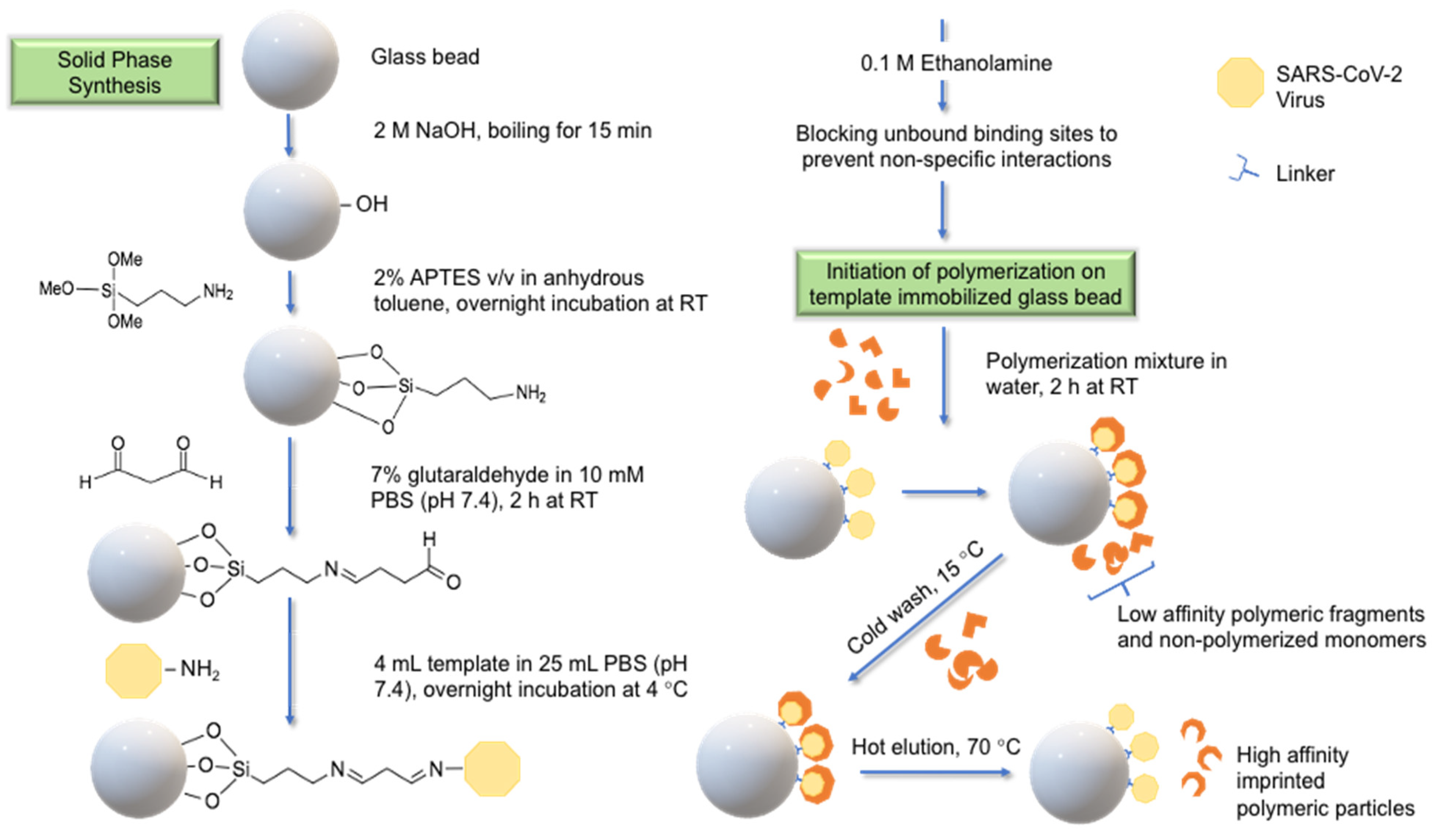
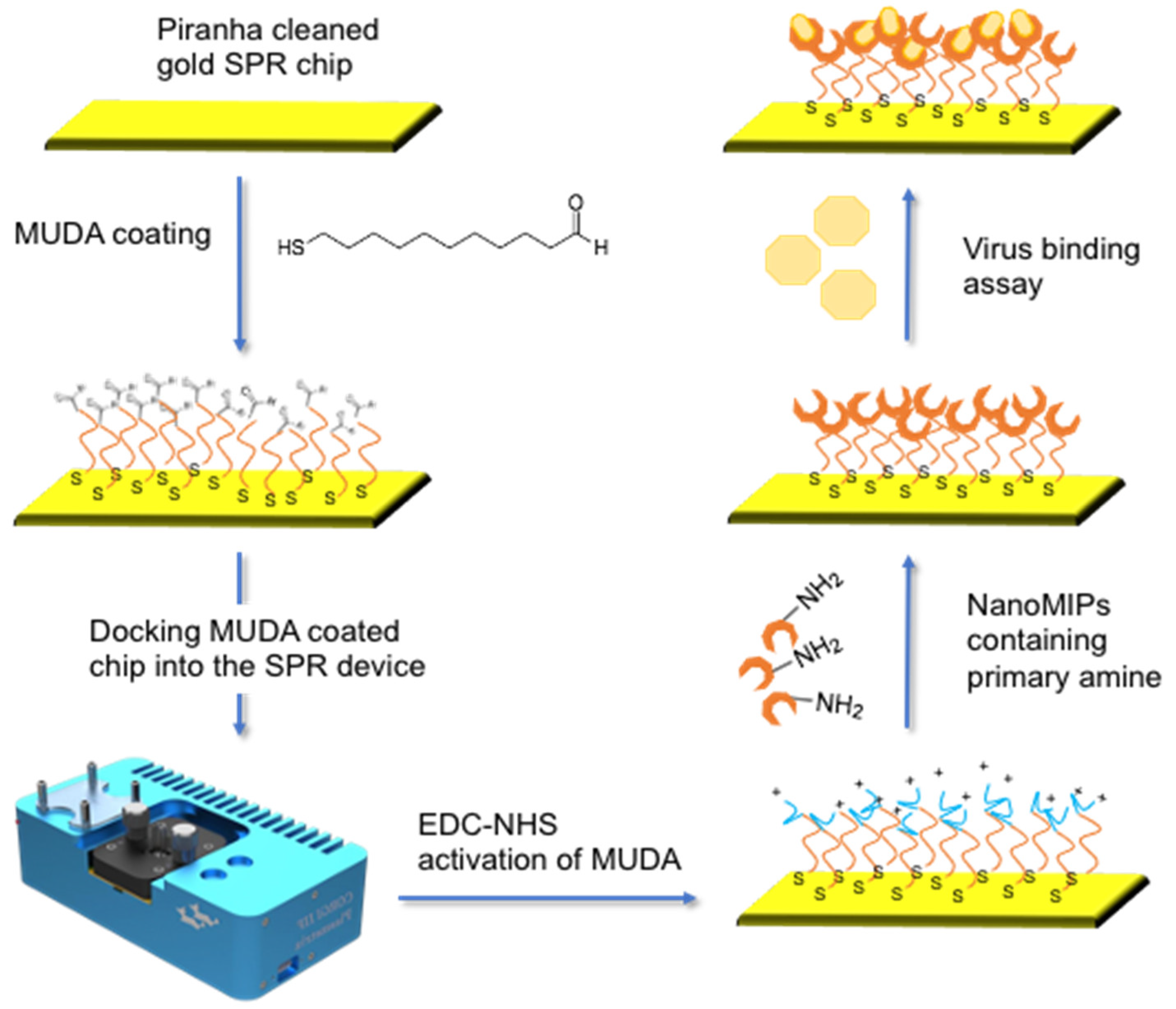
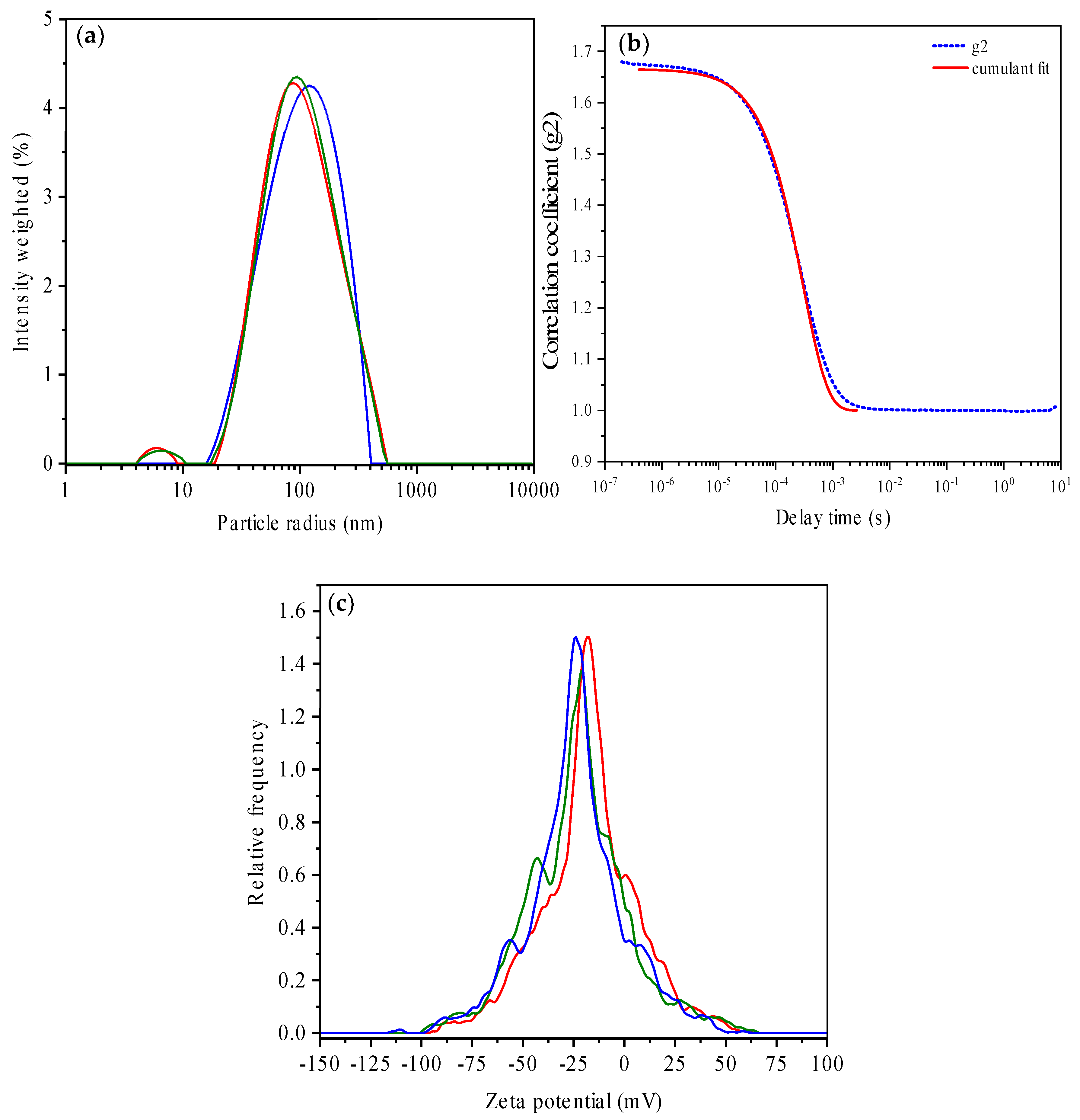
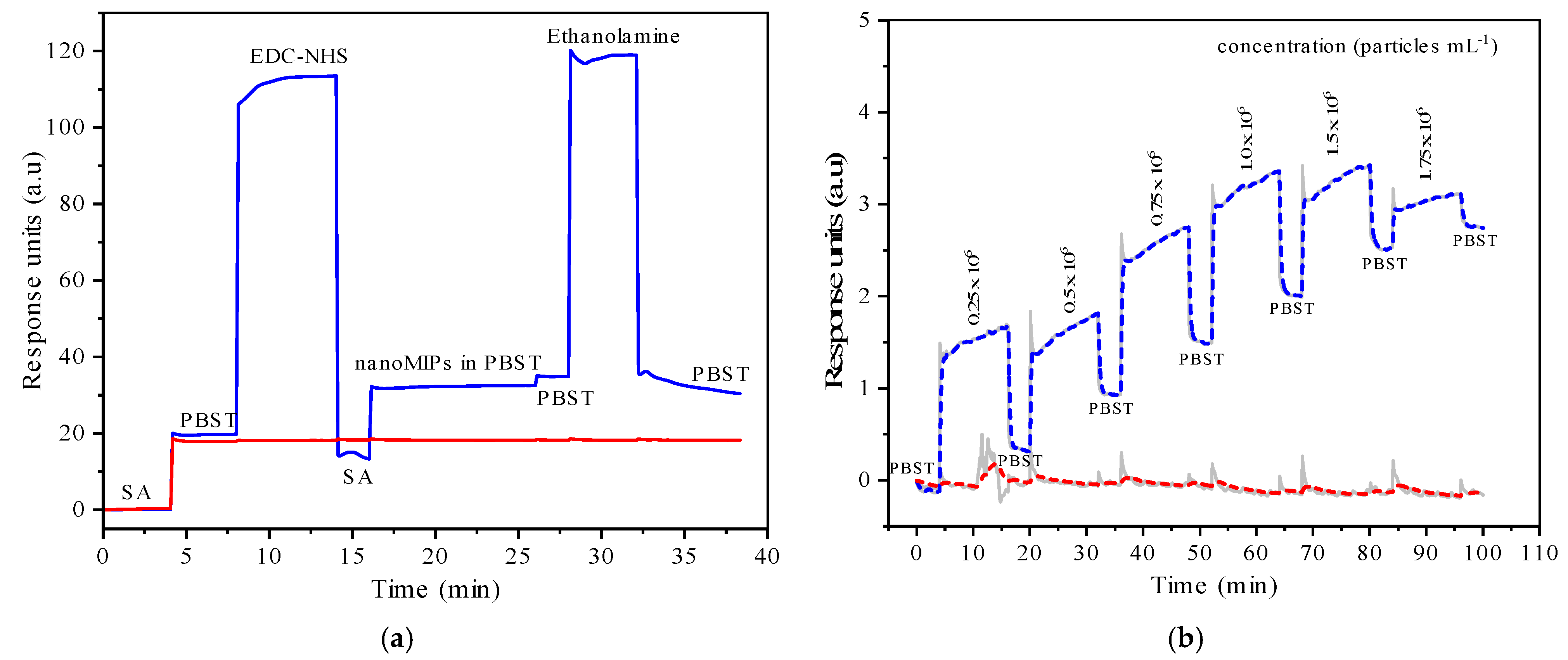
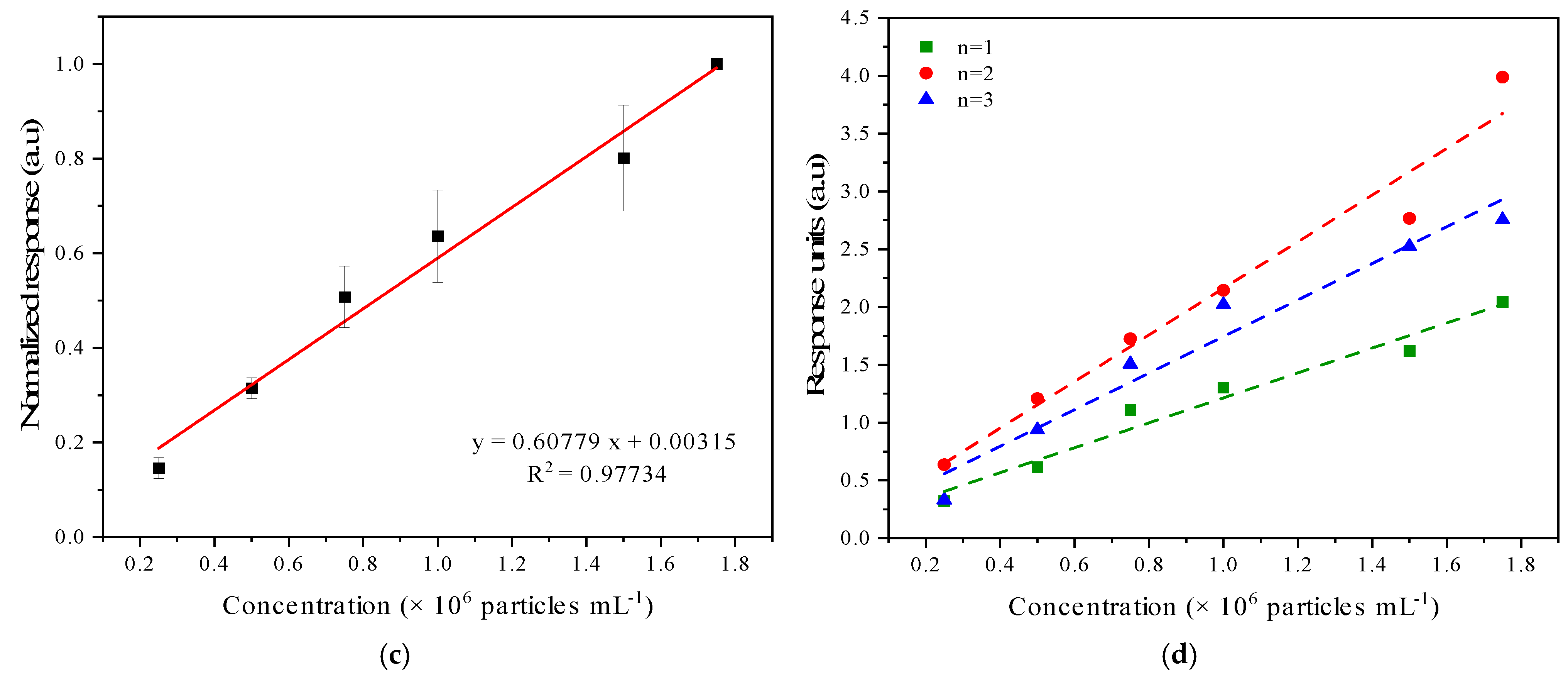



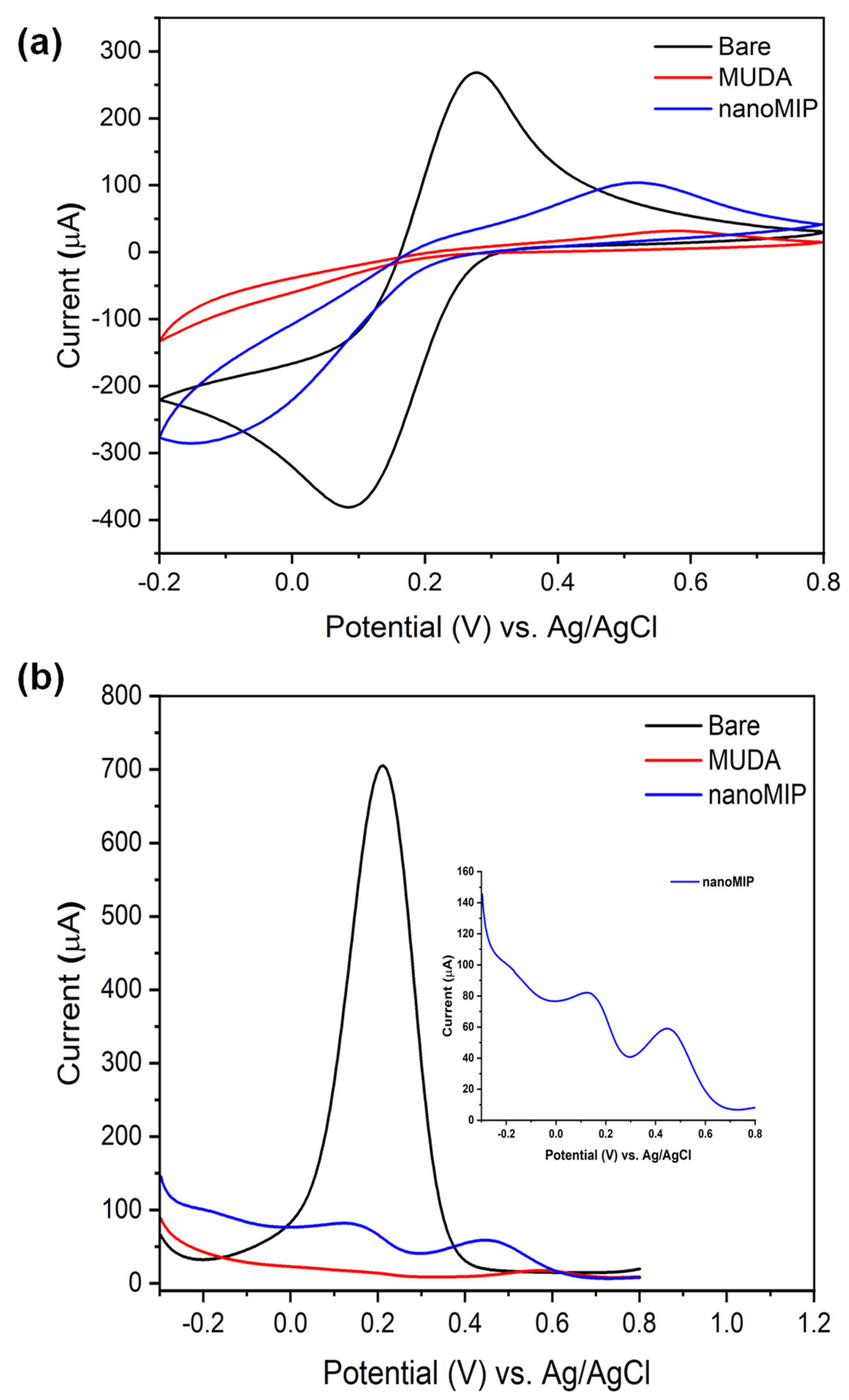
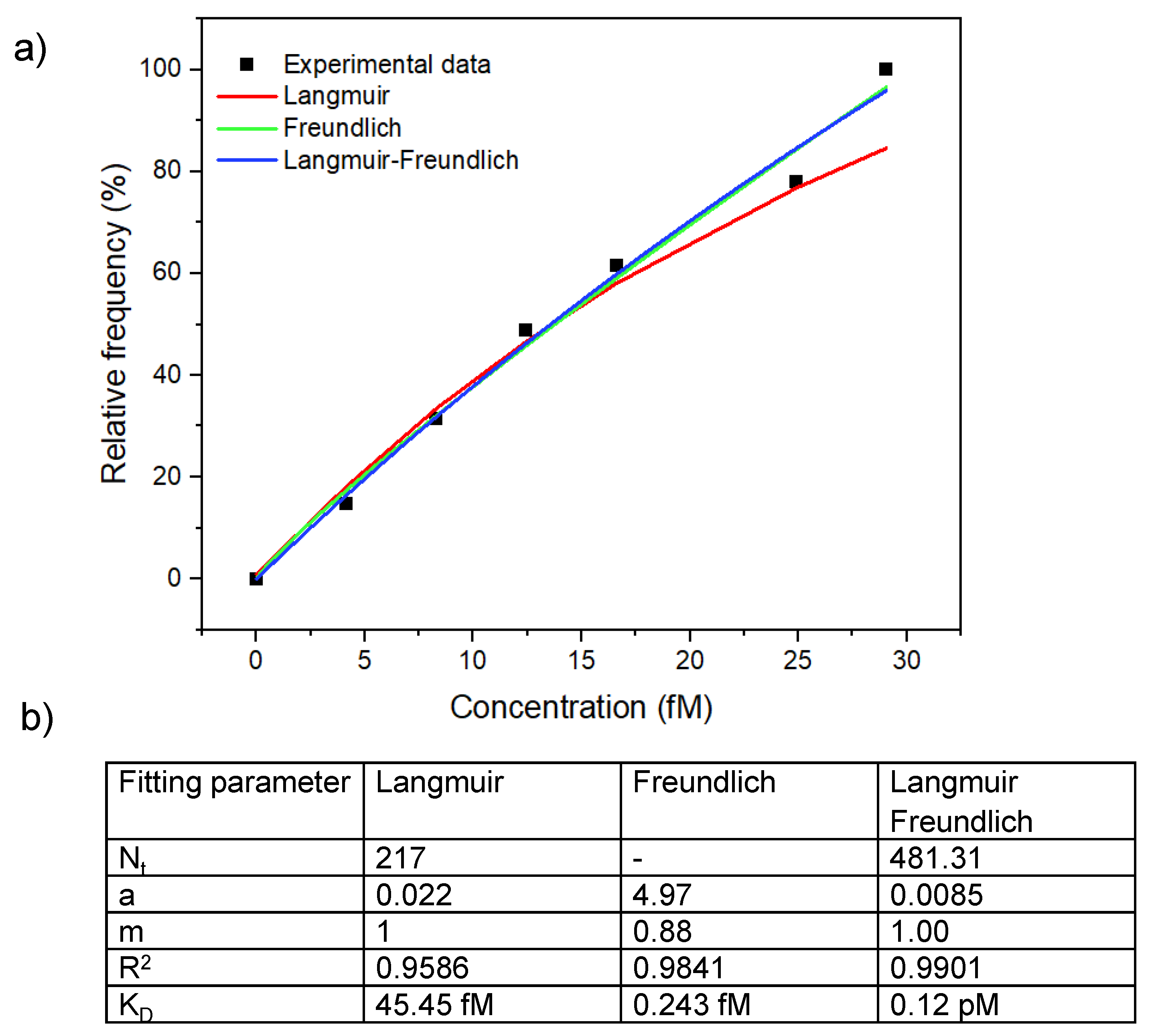
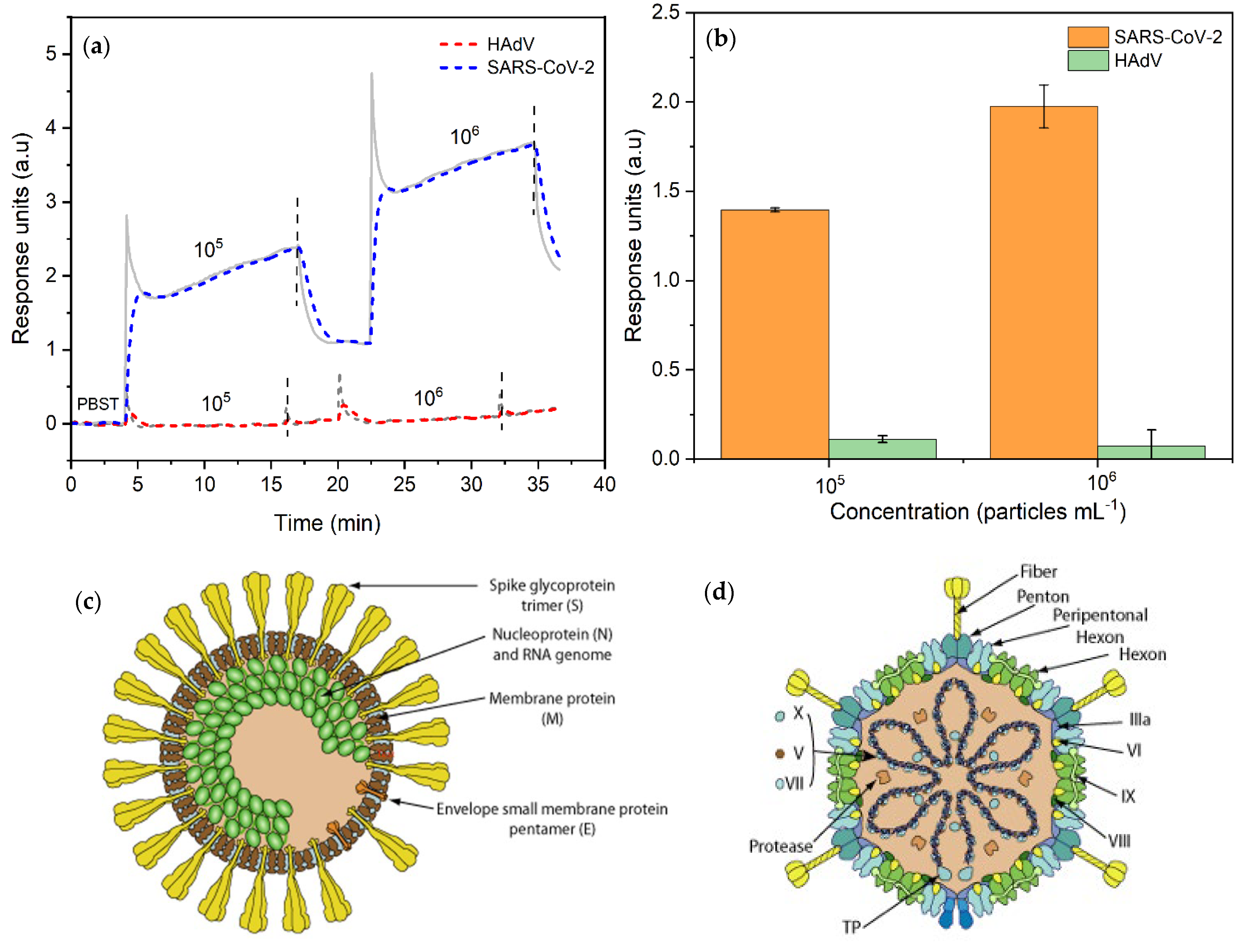
| Sensor Type | SARS-CoV-2 Biomarker | Detection Method | Concentration Range | LOD | Sample Volume | Detection Time | Ref |
|---|---|---|---|---|---|---|---|
| CRISPR/Cas12a and aptamers as receptor | Nucleocapsid protein (Np) | Fluorescence | 0.19–2.98 fM of Np | 0.17 fM (~2 copies μL−1) | 1 μL | 20 min | [19] |
| LAMP-based Electrochemical sensor | Np and ORF1ab gene | SWV | 0.001–10,000 × 10−3 ng μL−1 | 38 × 10−6 ng μL−1 | 50 μL | 30 min | [20] |
| Nanoenzyme-linked Immunochromatographic sensor | Np | Colorimetric | 0.01563–8 ng mL−1 (linear range: 0.05–1.6 ng mL−1) | 0.026 ng mL−1 | 100 μL | 10 min | [21] |
| MIP-based Electrochemical sensor | Spike protein subunit S1 (ncovS1) | SWV | 26.7–194 fM | 15 fM in PBS and 64 fM in nasopharyngeal samples | - | 15 min | [22] |
| AuNano-cyc/ACE2 on cotton swab (COLOR) | Spike protein | Colorimetric | 10−12–10−6 g mL−1 | 0.154 pg mL−1 | - | 5 min | [23] |
| Zwitterionic peptide-assisted AuNP aggregation | Protease | Colorimetric | 3.2–55.3 μM | 33.4 nM | 120 μL | 10 min | [24] |
| Plasmonic Fiberoptic Absorbance Biosensors (P-FABs) | Np | Absorbance | 0.1–10,000 ng mL−1 (linear range: 0.1–100 ng mL−1) | 2.5 ng mL−1 | 25 μL | 10 min | [25] |
| Plasmonic (No-core Fiber-based optical transducer) | Spike protein | Spectral interrogation | 100–104 ng mL−1 | 8.49 ng mL−1 | 100 μL | 5 min | [26] |
| Graphene-based Electrochemical sensor | Spike protein (S1) | SWV | 260,520 and 1040 nM | 260 nM (20 μg mL−1) | 10 μL | 45 min | [27] |
| Magnetic bar-embedded droplet microfluidic sensor | Np | SERS | 0–10,000 PFU mL−1 | 0.22 PFU mL−1 | 30 μL | 10 min | [28] |
| Magneto-assay based on disposable Electrochemical sensor | Spike proteins | DPV | 0.0009–360 fg mL−1 | 0.35 ag mL−1 | 30 μL | 60 min | [29] |
| Portable Device | SARS-CoV-2 Biomarker | Concentration Range | Limit of Detection (LOD) | Sample Volume | Detection Time | Ref |
|---|---|---|---|---|---|---|
| MIP-based miniaturized angular SPR | Whole virus | 0.25–1.75 × 106 particles mL−1 | 3.15 × 104 virus particles | 100 μL | 20 min | This work |
| Screen printed electrochemical sensor using smartphone | RNA | 10−17–10−12 M | 3 aM (200 copies mL−1 in real samples) | 10 μL | <10 s | [42] |
| Portable electrochemical sensor (SenSARS) | Spike protein | 1–50 fg mL−1 | 1.065 fg mL−1 | 0.3 μL | 10 min | [43] |
| Electrical-double-layer gated field-effect transistor-based | Np | 0.4–400 ng mL−1 | 0.34 ng mL−1 (7.44 pM) in PBS and 0.14 ng mL−1 (2.96 pM) | 500 nL | 30 min | [44] |
| CRISPR-Cas-assisted droplet magnetofluidic device | RNA | 1 and 100 genome 100 μL−1 | 1 genome μL−1 | 100 μL | <30 min | [45] |
| LAMP-based rapid detection using handheld POC device | Np gene | 101–09 RNA copies μL−1 | 10 RNA copies | 4 μL (extracted RNA) | 20 min | [46] |
| Gox-modified interdigitated capacitive (DIDC) sensing | Spike protein S1 | 1.0 mg mL−1 −1.0 fg mL−1 | 1 fg mL−1 | 4 μL | 3 s | [47] |
| Wireless aptamer-based graphene field-effect transistor | Spike (S) and nucleocapsid (Np) protein | 0–200 nM of S and 0–100 nM for N protein | 1.28 PFU mL−1 for S and 1.45 PFU mL−1 for Np protein | - | 20 min | [48] |
Publisher’s Note: MDPI stays neutral with regard to jurisdictional claims in published maps and institutional affiliations. |
© 2022 by the authors. Licensee MDPI, Basel, Switzerland. This article is an open access article distributed under the terms and conditions of the Creative Commons Attribution (CC BY) license (https://creativecommons.org/licenses/by/4.0/).
Share and Cite
Bajaj, A.; Trimpert, J.; Abdulhalim, I.; Altintas, Z. Synthesis of Molecularly Imprinted Polymer Nanoparticles for SARS-CoV-2 Virus Detection Using Surface Plasmon Resonance. Chemosensors 2022, 10, 459. https://doi.org/10.3390/chemosensors10110459
Bajaj A, Trimpert J, Abdulhalim I, Altintas Z. Synthesis of Molecularly Imprinted Polymer Nanoparticles for SARS-CoV-2 Virus Detection Using Surface Plasmon Resonance. Chemosensors. 2022; 10(11):459. https://doi.org/10.3390/chemosensors10110459
Chicago/Turabian StyleBajaj, Aabha, Jakob Trimpert, Ibrahim Abdulhalim, and Zeynep Altintas. 2022. "Synthesis of Molecularly Imprinted Polymer Nanoparticles for SARS-CoV-2 Virus Detection Using Surface Plasmon Resonance" Chemosensors 10, no. 11: 459. https://doi.org/10.3390/chemosensors10110459
APA StyleBajaj, A., Trimpert, J., Abdulhalim, I., & Altintas, Z. (2022). Synthesis of Molecularly Imprinted Polymer Nanoparticles for SARS-CoV-2 Virus Detection Using Surface Plasmon Resonance. Chemosensors, 10(11), 459. https://doi.org/10.3390/chemosensors10110459








